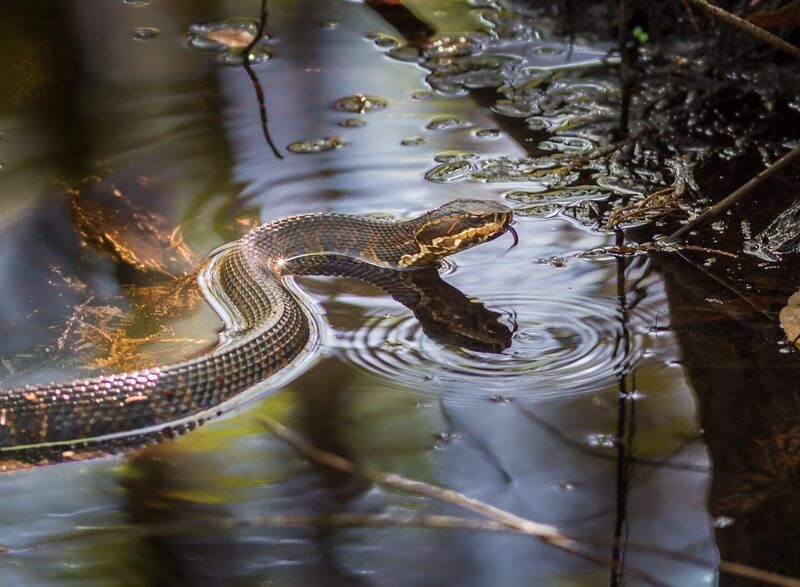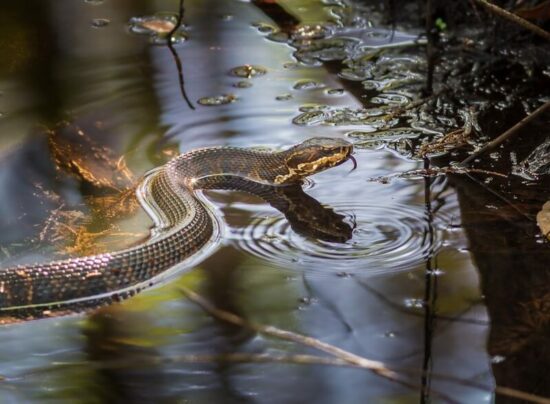Many people worry about snake bites when they’re out walking in the desert, but forget that some of these reptiles swim quite a bit as well.
This guide will teach you if snakes can bite underwater and provide other helpful information you should know.
Table of Contents
Can Snakes Bite Underwater?
With all the creatures that could be lurking under the surface of your favorite splash spot, snakes are often the last thing people worry about when swimming. But these slithery creatures do live in and around bodies of water. Many snake species stay close to ponds, rivers, streams, and marshes.
They are valuable sources of food and hydration. Because snakes are masters of disguise and naturally elusive, most people don’t even notice them nearby until they have a nasty encounter.
But can snakes bite underwater?
Unfortunately, snakes can bite you underwater. The reptiles are surprisingly agile, using an S-shaped swim pattern to zip through the water. Many also naturally float even when at rest.
If you’re unlucky enough to encounter a snake while swimming or wading through the water, they could bite you. But the good news is that underwater snake bites are relatively rare. They do occur from time to time, but in a vast majority of cases, it’s because the snake was provoked or threatened.
Snakes have no interest in humans. In fact, many sense human presence and flee before you even get a chance to see them!
It’s only when people accidentally get too close that there’s a problem. Stepping or sitting on a snake will result in a defensive action. Most will change their pose to look more aggressive.
If you continue to invade its space and act as a threat to the snake, it will retaliate with a bite.
What Snakes Spend Time In Water?
There are a handful of snake species you have to watch for when getting into natural bodies of water. Some spend a lot of time swimming. Others only get into the water to hunt.
Here are some of the most common snakes that might bite you underwater.
Cottonmouths
Cottonmouths are, by far, one of the most feared water snakes. These creatures are most prevalent in the Southwest United States. They usually live in small ponds, swamps, irrigation ditches, and other bodies of water.

Also known as water moccasins, these snakes are a type of pit viper. They have a small pit between their eyes that is sensitive to heat.
The head is pretty flat, and it floats on top of the water. Cottonmouths spend a decent amount of time in the water. You can often see them zipping on the water’s surface searching for food. If they’re not in the water, they’re usually around it, hiding in some tall grass or brush.
These snakes get their distinct name from their habit of showing off the inside of their mouths. When they feel threatened, Cottonmouths turn their heads upward and open their mouths to reveal the crisp white tissue lining the inside of their mouth cavity. Water moccasins can bite underwater, and are one of the first snakes people think of when they worry about underwater bites.
Water Snake
Water snakes are common reptiles native to North America. The term “water snakes” is a generic moniker used to describe several unique species. The most common include Northern water snakes, banded water snakes, and brown water snakes.
The snakes are appropriately named for their aquatic behavior. They spend plenty of time in the water. Typically, they float as they swim and sink when they stop to observe their surroundings. When aggravated these snakes will bite underwater, so you should be mindful if swimming in their territory.
Sea Snakes
Sea snakes are one of the most agile aquatic snake species there are! While others swim through the water to get around and find food, sea snakes can stay underwater for up to an hour!
They don’t just stick to the surface. These snakes will dive deep and meander through underwater coral to hunt. As you can guess by the name, these snakes are marine animals that live in saltwater environments.
There are around 50 or so unique sea snake species. Most are about five to six feet long and have enormous lungs for storing oxygen. Given that they spend so much time underwater, it’s only natural that these snakes will bite underwater as well.
Copperheads
Copperheads are another snake species that live in ponds, streams, swamps, and other common bodies of water. They have relatively broad distribution throughout the United States. As a result, they’re more common than the other variants.
Like cottonmouths, copperheads are pit vipers. They’re usually yellow or copper-colored, hence their common name. The easiest way to identify a Copperhead is by looking at its banding.
The bands look like an hourglass instead of solid stripes or irregularly shaped blobs.
Rattlesnakes
Rattlesnakes are one of the most identifiable snakes in the United States. They rattle their tails to create an unmistakable warning sound when they feel threatened.
Many people assume that these snakes live in deserts or dry sandy areas. However, they can also reside in swampy lands near water, and they can bite you underwater.
Even though rattlesnakes don’t spend a ton of time in the water, they’re fully capable of swimming when they need to.
There are about 25 species of rattlesnakes in the United States, and each one has that signature tail. While feared across the country, these snakes aren’t as aggressive as they might seem. They prefer to scare threats off with their rattlers than go on the offense.
Coral Snakes
Coral snakes are colorful reptiles. They have bands of red, black, and yellow. A few different snake species have similar banding, but the old saying “Yellow against yellow kills a fellow,” helps people identify this snake in the wild.
Coral snakes have many physical features that help them navigate the water. Their bodies are flatter and more agile. Meanwhile, the tail acts as a paddle to propel the snake forward at surprisingly fast speeds.
These snakes are fully capable of delivering a painful bite underwater, but most prefer to stay away from humans. Instead, they like to lie under rocks or fallen logs.
Which Of These Underwater Snakes Are Poisonous?
Many of the above snakes are venomous.
Sea snakes are some of the most venomous in the world. The small coral snake is, too. It reportedly has the second most potent venom in the world next to the black mamba. However, its venom-delivery system isn’t as effective as other species.
Of course, rattlesnakes, copperheads, and cottonmouths are also venomous. Cottonmouths tend to be the most feared because of how much time they spend in the water. That’s why so many people are worried about underwater snake bites from that species in particular.
What To Do If You See One
Seeing a snake in the water is enough to get anyone’s heart racing. But consider yourself lucky! Spotting a snake with your eyes is better than accidentally stepping on one and getting bitten.
When you come across a snake in the water, remember one important thing: Do not panic!
As we said earlier, most snakes want nothing to do with humans. Even the venomous ones aren’t out to bite you. They only do that when they feel threatened.
If you go into panic mode and try to swim to safety or splash around, you’re only agitating it. You’re not scaring the snake away no matter how much splashing or yelling you do. Instead, you’re provoking it!
The best thing you can do is be still and observe. There’s a good chance that the snake has already noticed your presence. Give it a chance to move away from you.
Standing still gives the snake a way out, and it will retreat and hide. That’s your cue to head in the opposite direction.
Calmly make your way to the dry land. As you go, be mindful of anything else in the water. Snakes often disguise themselves under sticks or rocks near the water’s edge. The last thing you want is to encounter another snake on your way out!
What Should You Do If A Snake Bites You Underwater?
If you’re unfortunate enough to get bit by a snake underwater, seek medical attention immediately.
Cottonmouths, copperheads, rattlesnakes, and other venomous species are fully capable of killing a human being. Those bites are medical emergencies, and you need to seek care as soon as possible.
Go to a local hospital. Most hospitals have easy access to antivenom for snakes in the local area. It’s the best way to negate the effects of the bite and minimize the damage.
Even if you’re bitten by a nonvenomous species, seeking medical care should still be your top priority. Snakes can leave behind teeth. Plus, there’s the issue of bacteria.
Bites from nonvenomous snakes can get infected and cause a host of issues in the long run. Get care even if you feel fine. You never know what that bite can do to you.
Conclusion
Snakes can bite underwater, but this occurrence is quite rare (especially if you take precautions while swimming). With that being said, it’s good to be aware of this possibility so you can keep yourself safe and know what to do if a bite does occur.
If there’s anything in this guide you have questions about or want a clarification on, feel free to get in touch with us. We love connecting with our readers and providing more information!


